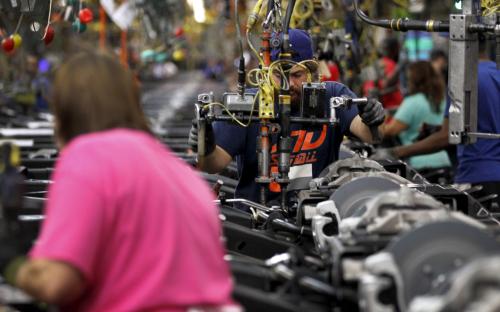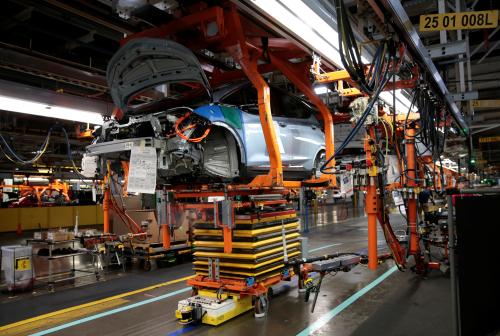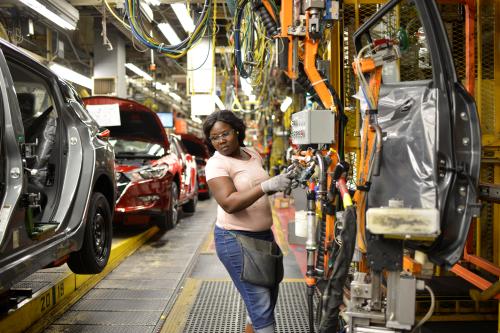These comments were prepared for the inaugural conference on “Automation and the Middle Class” for the Brookings Institution, Future of the Middle Class Initiative. The original paper can be found here.
Nir Jaimovich and Henry Siu have written a very helpful and useful paper that summarizes the empirical literature by labor economists on how automation affect the labor market and the middle class.
Their main arguments can be summarized as follows:
- The labor markets in the US (and other industrialized countries) has become increasingly “polarized” in recent decades, as wage and employment have grown at the top and bottom of the market while they have declined in the middle.
- The polarization has mostly been driven by skill-biased technical change (rather than globalization), with automation replacing workers performing mostly routine tasks in production and clerical occupations.
- Less-educated workers and especially men have been most hurt by these forces, with many exiting the labor force as their prospective earnings have fallen.
- These forces will likely continue to occur as robotics and artificial intelligence (AI) spread throughout the labor market in the coming years and decades.
- But humans will retain a “comparative advantage” relative to machines in many jobs, especially those requiring the performance of social and interactive personal tasks.
- Policy options such as retraining displaced workers for such jobs look promising and should be further explored.
I find most of these arguments quite reasonable and well-supported by the evidence they provide. At the same time, their presentation of the literature on job polarization is a bit one-sided. Counter-arguments and evidence such as that provided by Hunt and Nunn (2019) get very little attention in this paper.
While the authors do acknowledge a few important and contrary points – such as the far greater growth of employment in low-wage than high-wage occupations since the Great Recession – a more balanced discussion of this literature would have been welcome. For instance, nowhere do they even acknowledge evidence that labor market outcomes may have been heavily affected by institutional as well as market forces, as Fortin et al. (2018) have recently shown. And the important growth of middle-paying jobs requiring some postsecondary education in health care, information technology and other fields is only acknowledged towards the very end of the paper.
More broadly, I find the paper useful as a summary of the mostly academic research among economists in this area, but it ignores other important research and policy analysis on these issues. As such, the paper is extremely cautious when it comes to fleshing out the likely future effects of automation in the labor market, as well as important policy prescriptions; and its appeal to more applied audiences will be limited.
For instance, on the supply (worker) side of the labor market, social scientists have reviewed the most important “21st century skills” that will likely complement automation – besides just social/interactive ones (National Academies of Science, 2014). On the demand side, it is clear that employers have many choices on how to implement automation (Helper et al., 2019) – and that worker voice in this process can really affect outcomes such as whether workers are retrained for new jobs or displaced. Recent trends on the demand side that will likely inhibit worker voice in these matters – such as the increasingly “fissured” workplace in which responsibility for training and other human resource functions is outsourced to other firms (Weil, 2014) – will affect outcomes as well.
The broad range of social, economic, institutional, and policy forces that will determine the pace and nature of automation (National Academies of Science, 2017) need more coverage here. The likely labor market effects of future automation in the labor market could also be fully fleshed out. For instance, it is likely that automation will raise average worker productivity and therefore compensation over time, but inequality will probably rise while labor force participation falls (Holzer, 2019). Automation will continue to hurt less-educated workers relatively more than those more-educated, as the incidence of displacement will be higher among the former while adjustments through the development of skills that complement automation will be more successful among the latter.
If accurate, these projections also imply the need for policies that go well beyond those reviewed by Jaimovich and Siu. Such policies might include:
- Greater efforts to teach students a range of “21st century skills” in grades K-12 and beyond;
- Lifelong learning accounts for workers that will pay for new skill development (Fitzpayne and Pollack, 2018) when they face displacement, as well as efforts to make new training more accessible to working students (through online teaching platforms);
- Improving the quality of displaced worker training in the labor market, which now has limited success (Jacobson et al., 2005);
- Subsidizing employer provision of on-the-job training for workers facing imminent displacement;
- Raising taxes on employers who displace workers (but not on adoption of robotics or AI per se) beyond that currently provided by experience rating in the Unemployment Insurance system;
- Strengthening the workforce development system through more resources for One-Stop offices and certificate programs in community colleges;
- Strengthening worker “voice” in the workplace (Kochan and Kimball, 2019); and
- Providing wage insurance for displaced workers who can only gain new jobs at well below their former levels of pay.
Thus, while the paper by Jaimovich and Siu provides a useful review of the academic literature on automation and polarization by labor economists, we should cast a wider net when discussing their potential labor market effects and appropriate policy responses.







Commentary
Comments on “How automation and other forms of IT affect the middle class: Assessing the estimates” by Jaimovich and Siu
November 7, 2019